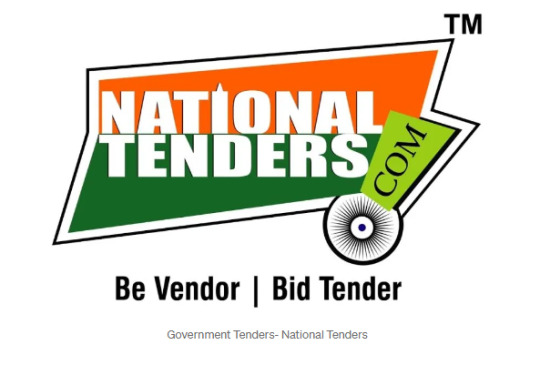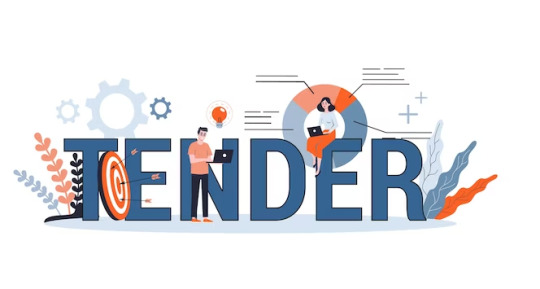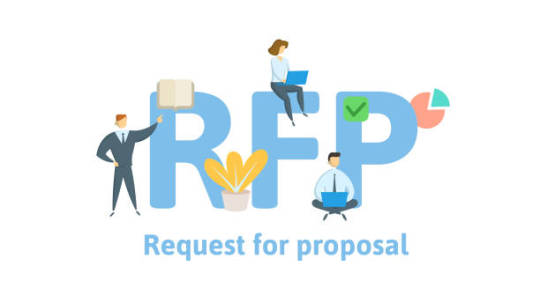Text

As a business owner or manager, you know the importance of seizing new opportunities and winning contracts through tender submissions. Yet, the process can be daunting and time-consuming. That's where National Tenders comes in. This post explores why outsourcing tender submissions to them is a smart choice. Learn how their expertise can simplify your operations, enhance competitiveness, and fuel your business growth.
0 notes
Text
Mastering the GeM portal tender search is essential for businesses in India's government procurement sphere. GeM's transparency and efficiency make it a crucial platform. By following our guide and utilizing tools like National Tenders, businesses can position themselves for success in securing government contracts. Embrace the opportunity, explore GeM, and thrive in the tendering landscape.
0 notes
Text
Mastering the GeM portal tender search is essential for businesses in India's government procurement sphere. GeM's transparency and efficiency make it a crucial platform. By following our guide and utilizing tools like National Tenders, businesses can position themselves for success in securing government contracts. Embrace the opportunity, explore GeM, and thrive in the tendering landscape.
0 notes
Text
Balaghat Tenders serve as a catalyst for business growth and development, offering a plethora of opportunities across various sectors. By leveraging platforms like National Tenders, businesses can stay abreast of the latest tender listings, enabling them to capitalize on emerging opportunities in Balaghat and beyond. Whether you’re a seasoned player or a budding entrepreneur, exploring Balaghat Tenders could be the strategic move that propels your business to new heights of success.
#Balaghat Tenders#Latest Balaghat Tenders#Online Balaghat Tenders#Balaghat Tenders 2024#Government Tenders
0 notes
Text
The GeM portal not only streamlines government procurement through a user-friendly registration process but also offers businesses a myriad of advantages, from an expansive market reach to a transparent procurement system. With timely payments, direct engagement with government buyers, and reduced marketing costs, GeM proves to be a transformative platform in India's digital age. The seamless registration process and an array of benefits make GeM an attractive opportunity for businesses of all sizes, encouraging active participation in government tenders and contributing to the nation's journey toward a more transparent, efficient, and digitally driven future.
0 notes
Text
Utilizing the National Tenders website provides more than just access to a extensive collection of government tenders; it also offers a streamlined platform that supports every stage of the tendering process. Whether you're in the discovery phase or preparing for submission, National Tenders can serve as your companion in navigating the intricate procedures involved in securing government contracts in India.
#government tender information#tender documents#Government Tenders#Online Tender Submission#National Tenders#Tender Information#Eprocurement Tender
0 notes
Text
In the landscape of KMTWWFB tenders, opportunities abound for businesses to not only thrive economically but also contribute meaningfully to the well-being of the motor transport workforce. Navigating these opportunities requires a blend of innovation, resilience, and a commitment to the broader social fabric of the community
#eprocurement tender#Kerala Motor Transport Workers Welfare Fund Board#KMTWWFB#KMTWWFB tenders#National Tenders
0 notes
Text
Explore the world of Government E-Marketplace (GeM) portal tenders and discover the immense potential it holds for your business. Learn how to access a vast customer base, streamline procurement, and promote transparency while overcoming challenges. Stay competitive in the digital era with GeM portal tenders!
0 notes
Text
National Tenders has proven that success in government procurement in India is within reach for businesses of all sizes. By simplifying the tender process, offering comprehensive services, and staying ahead of the curve in the evolving e-Procurement landscape, National Tenders has empowered businesses to streamline their path to success
0 notes
Text
Don’t miss out on the chance to grow your business through government tenders. Stay tuned for our upcoming articles where we’ll delve deeper into the nuances of GeM and provide you with the latest updates and tips to thrive in this dynamic ecosystem. Get ready to unlock the potential of GeM with the guidance of National Tenders and take your business to new heights!
0 notes
Text
Discover the wealth of opportunities in Jharkhand government tenders with National Tenders. Explore 2797+ live e-tenders, tap into rich mineral resources, and embrace eco-conservation projects. Stay ahead with timely updates and a user-friendly interface. Start your journey to growth and success today.
0 notes
Text
The Government e-Marketplace (GeM) acts as a trailblazing initiative, realigning the government procurement system with the dynamics of modern business. It is an unequivocal call to arms for businesses, especially SMEs and startups, to be a part of this transformative journey. As the Indian government embraces transparency, efficiency, and inclusivity in procurement, GeM emerges as a beacon of opportunity for businesses of all sizes, and platforms like National Tenders stand ready to usher them into this new era of government-business collaboration.
0 notes
Text
Unlocking Government Procurement: Government e-Marketplace (GeM)
India's Government e-Marketplace (GeM) has made a significant contribution to transforming government procurement, by streamlining the acquisition of common-use goods and services for various government bodies, organizations, and public sector bodies (PSUs). By presenting a transparent and efficient mechanism to satisfy the government's diverse needs, this platform has transformed how the Indian government sources its requirements.

The Indian government stands as one of the nation's largest purchasers, disbursing vast sums of capital for goods and services across an extensive spectrum of sectors. However, the path for Small and Medium-sized Enterprises (SMEs) and startups to engage with the government has been fraught with intricacies, labyrinthine procedures, and frustrating delays in payment. This obstacle-ridden landscape has hindered the potential participation of these dynamic entities in the government procurement ecosystem, effectively excluding them from the considerable opportunities it offers.
GeM: Rethinking Government Procurement
Government E-Marketplace (GeM) serves as a clarion call to transform this paradigm. GeM endeavors to shatter the barriers erected by complex bureaucratic processes, rendering them obsolete. At its core, GeM aims to infuse an element of transparency, efficiency, and simplicity into the government procurement process, thereby revolutionizing how government agencies procure goods and services. This bold endeavor aligns seamlessly with the overarching mission of ushering in a new era of efficiency and accountability within the governmental machinery.
Key Features and Objectives
GeM's primary objective is to usher in a sea change in the way the Indian government acquires its requisites. Key features and objectives of GeM include:
Simplification: GeM offers a user-friendly and intuitive platform, simplifying the buying and selling process for government entities and vendors alike.
Inclusivity: It is designed to include SMEs, startups, and diverse businesses, breaking down the barriers that previously hindered their engagement with government procurement.
Transparency: GeM introduces a level of transparency hitherto unseen, ensuring fairness, competitiveness, and unbiased access to opportunities.
Efficiency: By eliminating the inefficiencies associated with traditional procurement methods, GeM accelerates the acquisition process, benefiting both buyers and sellers.
Payment Assurance: GeM introduces swift payment processes, ensuring that vendors, particularly SMEs, and startups, receive their dues without inordinate delays.
In this landscape, National Tenders emerges as a vital ally for businesses aspiring to navigate the world of government tenders with finesse. Recognizing the need for expert guidance in the realm of tendering and bidding, National Tenders stands as India's premier tender search and submission portal. With a dedicated team of experts well-versed in the nuances of tendering, the platform guides businesses to discern and select pertinent tenders, as well as compile the essential documentation required for successful bidding.
In conclusion, the Government e-Marketplace (GeM) acts as a trailblazing initiative, realigning the government procurement system with the dynamics of modern business. It is an unequivocal call to arms for businesses, especially SMEs and startups, to be a part of this transformative journey. As the Indian government embraces transparency, efficiency, and inclusivity in procurement, GeM emerges as a beacon of opportunity for businesses of all sizes, and platforms like National Tenders stand ready to usher them into this new era of government-business collaboration.
Source Blog :https://medium.com/@seo.nationaltenders/unlocking-government-procurement-government-e-marketplace-gem-41be6ff0ec54
0 notes
Text
The Bid Validity Period plays a crucial role in the tendering process, promoting openness, dedication, and efficient interaction between buyers and bidders. By grasping its significance and following recommended approaches, businesses can maneuver through the complexities of bid validity. This guarantees favorable procurement results and cultivates robust business associations in the competitive realm of tendering.
0 notes
Text
Understanding a Tender Notice Format and Its Key Elements
What is a Tender Notice?
In the realm of business and procurement, a tender notice plays a crucial role in initiating the process of soliciting bids or proposals from qualified suppliers or service providers. It is essentially a formal announcement or advertisement issued by a company, government agency, or organization, inviting potential suppliers to submit their offers for a specific project, contract, or procurement opportunity. The tender notice serves as a crucial communication tool to inform the interested parties about the requirements, conditions, and guidelines they must follow while participating in the bidding process.
Tender Notice Format: Understanding the Structure of a Tender Notice
A well-structured tender notice is essential to ensure clarity and transparency throughout the bidding process. While the format may vary slightly depending on the issuing authority and the nature of the project, the following elements are typically included:
Title/Heading: At the top of the tender notice, there is a clear and concise title that outlines the nature of the opportunity or project for which bids are being sought.
Issuing Authority Details: This section provides information about the organization or entity issuing the tender notice. It includes the name of the organization, address, contact details, and any references such as a tender identification number.
Introduction and Background: The tender notice should provide a brief introduction to the project or opportunity, including the purpose and objectives. It may also include the background of the project and its significance in relation to the organization's goals.
Scope of Work: This section elaborates on the specific scope of work or services required. It should be detailed enough for potential bidders to understand the expectations and deliverables clearly.
Eligibility Criteria: Here, the tendering authority outlines the minimum requirements that bidders must meet to be considered eligible for participation. This could include financial capacity, past experience, technical expertise, and other relevant qualifications.
Tendering Process and Timeline: The tender notice should specify the exact process for submitting bids, including the required documents and any prescribed format. Additionally, it should outline the key dates such as the deadline for bid submission, pre-bid meetings (if any), and the date of bid opening.
Evaluation Criteria: This section provides insights into how the submitted bids will be evaluated and the factors that will be considered during the assessment process. It helps bidders to align their proposals accordingly.
Terms and Conditions: All relevant terms and conditions that govern the tendering process and the subsequent contract, if awarded, should be explicitly stated. This includes details about performance bonds, payment terms, indemnities, and other legal aspects.
Contact Information: The tender notice must include contact details of a designated person or department whom interested bidders can reach out to for clarification or inquiries.
Key Elements of a Tender Notice
Clear and Concise Language: The language used in the tender notice should be simple, unambiguous, and easy to understand, avoiding any jargon or technical terms that might confuse potential bidders.
Accurate and Detailed Information: Every aspect of the tender notice should be accurate and provide sufficient details to enable potential bidders to make informed decisions.
Transparency and Fairness: The tender notice should be transparent, providing a level playing field for all bidders and ensuring a fair evaluation process.
Compliance with Legal Requirements: It is essential to ensure that the tender notice complies with all relevant laws, regulations, and policies governing the procurement process.
In conclusion, understanding the tender notice format and its key elements is vital for both the issuing authority and potential bidders. A well-structured tender notice not only attracts competent bidders but also facilitates a smooth and efficient procurement process, ultimately leading to the selection of the most suitable candidate for the project or contract.
0 notes
Text
Efficiency and Transparency Unleashed: Harnessing the Power of RFPs in Government Tenders and e-Procurement
Introduction:
In today’s digital era, eTendering has revolutionized the government procurement process, making it more efficient, transparent, and accessible. Request for Proposals (RFPs) plays a vital role in this transformation, enabling government organizations to solicit competitive bids from potential suppliers through e-procurement platforms. In this blog post, we will delve into the significance of RFPs in government tenders and e-procurement, highlighting their benefits, key components, and best practices to ensure successful outcomes.

Understanding RFPs in Government Tenders and e-Procurement:
Before exploring the intricacies of RFPs in government tenders and e-procurement, it is essential to grasp their fundamental concept. A Request for Proposal is a formal document that outlines the requirements, specifications, and desired outcomes of a project or procurement. It serves as a powerful tool for government organizations to communicate their needs to potential vendors and elicit comprehensive and competitive bids through e-procurement platforms.
Streamlining the Government Procurement Process:
Implementing eTendering with RFPs as a central component offers numerous advantages in government tenders and e-procurement, including:
a. Enhanced Efficiency: By leveraging e-procurement platforms, government organizations can streamline the tendering process, minimizing manual paperwork and administrative tasks. RFPs can be published online, allowing suppliers from anywhere to access and respond to them promptly, saving time and resources.
b. Increased Competition: eTendering through e-procurement platforms opens doors for a broader pool of suppliers to participate in government tenders. This increased competition can drive better pricing, improved quality, and innovative solutions, ultimately benefiting the government and taxpayers.
c. Improved Transparency: Transparency is paramount in government tenders to ensure fairness, integrity, and accountability. With eTendering, RFPs and their subsequent evaluations are conducted electronically, creating an auditable trail and ensuring transparency at every stage of the procurement process.
d. Standardized Tender Documents: RFPs provide a structured framework for government organizations to define and standardize tender documents. This consistency enables vendors to understand and respond to the requirements more effectively, leading to better-aligned proposals.
Key Components of an RFP in Government Tenders:
To effectively solicit bids and facilitate informed decision-making in government tenders and e-procurement, an RFP typically includes the following sections:
a. Introduction: Provides an overview of the tender, the government organization, and the objectives of the project.
b. Scope of Work: Clearly defines the requirements, deliverables, timelines, and any specific constraints associated with the government tender.
c. Evaluation Criteria: Specify the factors that will be used to assess the proposals, including technical capabilities, pricing, past performance, compliance requirements, and any specific criteria relevant to the government organization.
d. Technical Specifications: Outlines the technical requirements, standards, and performance expectations expected from potential suppliers.
e. Proposal Format: Outlines the structure and format expected for the submitted proposals, including necessary documents and supporting information.
f. Contractual and Legal Requirements: Includes terms and conditions, payment terms, intellectual property rights, and any other legal obligations specific to the government tender.
Best Practices for RFPs in Government Tenders and e-Procurement:
To ensure the success of an RFP in government tenders and e-procurement, government organizations should consider the following best practices:
a. Clearly Define Requirements: A well-defined scope of work, technical specifications, and tender document leave no room for ambiguity, enabling suppliers to provide accurate and competitive proposals.
b. Encourage Questions: Providing a platform for potential suppliers to seek clarifications promotes a better understanding of the government tender, ensuring accurate and comprehensive bids.
c. Establish Clear Evaluation Criteria: Define evaluation criteria in advance, outlining their relative importance to guide suppliers in tailoring their proposals accordingly.
d. Engage Stakeholders: Involving relevant stakeholders during the RFP development process ensures that all perspectives are considered, increasing the chances of project success and stakeholder satisfaction.
e. Maintain Transparency: Keep the entire process transparent and maintain clear communication with all bidders to foster trust and integrity throughout the government tender process.
Conclusion:
The integration of RFPs into eTendering has transformed government tenders and e-procurement, enabling government organizations to streamline processes, increase competition, and enhance transparency. By harnessing the power of e-procurement platforms and following best practices, governments can unlock efficiency and transparency, find the most suitable suppliers, and ultimately deliver better outcomes for their constituents. RFPs in government tenders and e-procurement serve as catalysts for driving innovation, achieving cost savings, and fostering trust in the procurement process
Source: https://medium.com/@seo.nationaltenders/efficiency-and-transparency-unleashed-harnessing-the-power-of-rfps-in-government-tenders-and-536d2a28a62a
0 notes
Text
Finding public sector contracts can be a challenging process, but by reading the tender details cautiously, you can locate the contracts suitable for your business and increase your chances of winning a bid. When trying to find a project to bid on, there are a few key tips to keep in mind. One of the best resources to have on hand is an online tender portal like National Tenders, which can help you find contracts across India that might fit your business's qualifications and needs.
0 notes